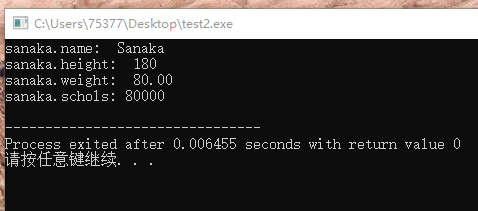c语言中将结构体对象指针作为函数的参数实现对结构体成员的修改。
1、
#include <stdio.h> #define NAME_LEN 64 struct student{ char name[NAME_LEN]; int height; float weight; long schols; }; void hiroko(struct student *x) // 将struct student类型的结构体对象的指针作为函数的形参 { if((*x).height < 180) // x为结构体对象的指针,使用指针运算符*,可以访问结构体对象实体,结合.句点运算符,可以访问结构体成员,从而对结构体成员进行修改。 (*x).height = 180; if((*x).weight > 80) (*x).weight = 80; //因为传入的是结构体对象的指针,因此可以实现对传入的结构体对象的成员进行修改 } int main(void) { struct student sanaka = {"Sanaka", 173, 87.3, 80000}; hiroko(&sanaka); //函数的实参需要是指针,使用取址运算符&获取对象sanaka的地址 printf("sanaka.name: %s ", sanaka.name); printf("sanaka.height: %d ", sanaka.height); printf("sanaka.weight: %.2f ", sanaka.weight); printf("sanaka.schols: %ld ", sanaka.schols); return 0; }

等价于以下程序(使用箭头运算符 ->)
#include <stdio.h> #define NAME_LEN 64 struct student{ char name[NAME_LEN]; int height; float weight; long schols; }; void fun(struct student *x) // 函数的形参为指向struct student型的对象的指针 { if(x -> height < 180) // 指针 + ->(箭头运算符)+ 结构体成员名称 可以访问结构体成员,从而实现结构体成员值的修改 x -> height = 180; if(x -> weight > 80) // 箭头运算符 -> 应用于结构体对象指针,访问结构体对象的结构体成员 x -> weight = 80; } int main(void) { struct student sanaka = {"Sanaka", 173, 87.3, 80000}; fun(&sanaka); // 函数的形参为struct student型的结构体对象指针, 因此使用取址运算符&传入结构体对象sanaka的地址(指针), printf("sanaka.name: %s ", sanaka.name); printf("sanaka.height: %d ", sanaka.height); printf("sanaka.weight: %.2f ", sanaka.weight); printf("sanaka.schols: %ld ", sanaka.schols); return 0; }

箭头运算符 只能应用于结构体对象的指针,访问结构体对象的成员, 不能应用于一般的结构体对象。比如 sanaka -> height 会发生报错。